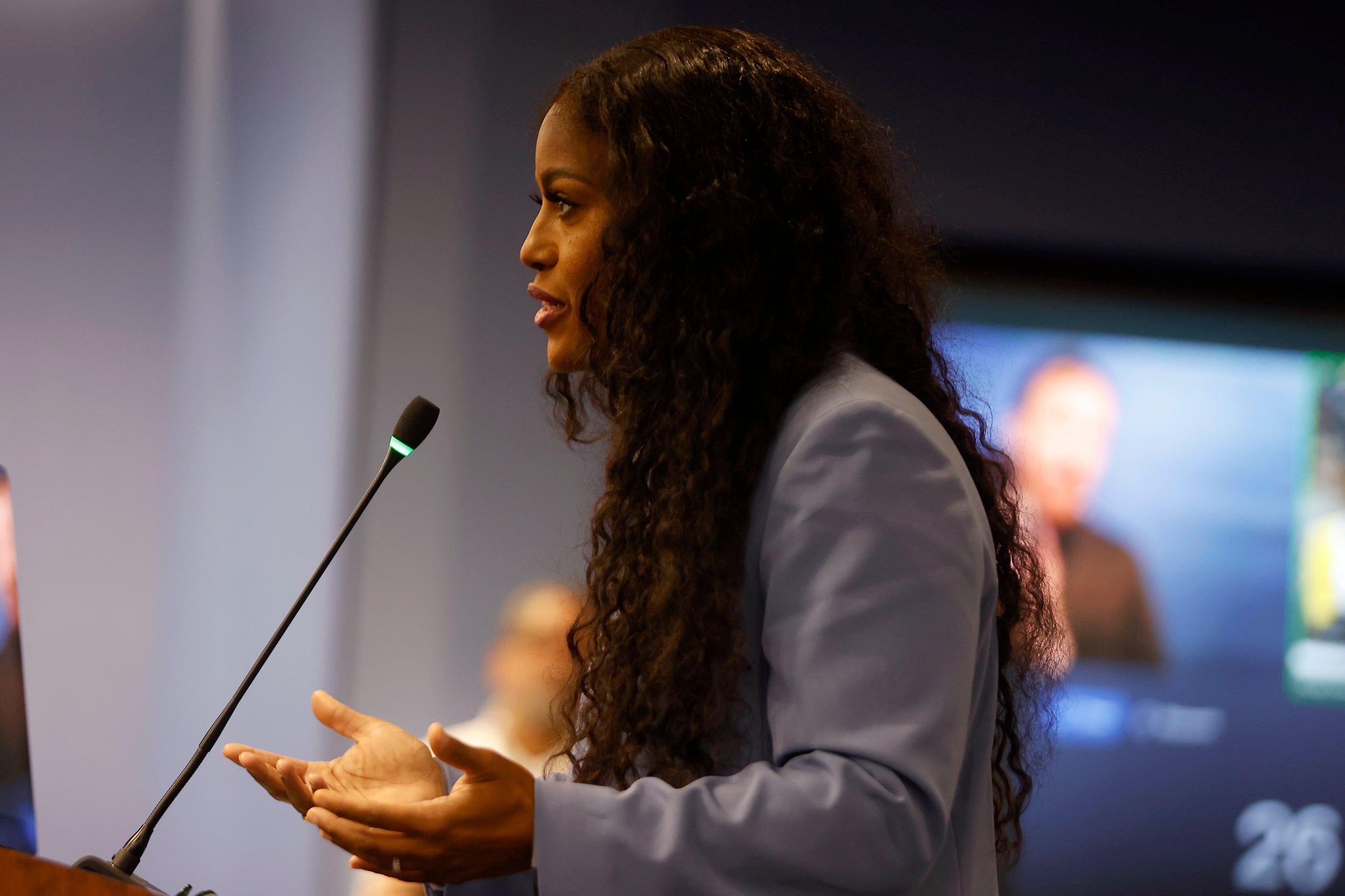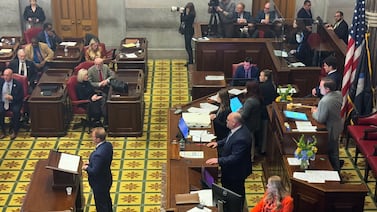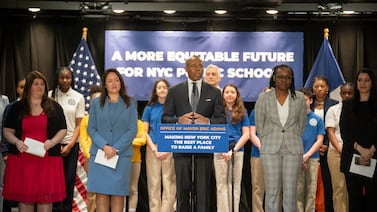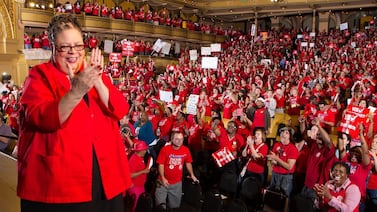Sign up for Chalkbeat Chicago’s free daily newsletter to keep up with the latest news on Chicago Public Schools.
The Chicago Teachers Union and Chicago Public Schools reached a tentative contract agreement Monday night that would reduce class sizes in some grades, add hundreds of new positions, and give elementary school teachers more preparation time while many students get more recess.
The deal would also grant teachers a 4% raise retroactively to cover the first year of the contract, which is the current school year, and 4-5% for each of the next three years.
The deal secures significant wins that the union left on the table during a bruising, lengthy strike in 2019 and comes after it pushed hard for its most ambitious, costliest slate of demands to date. But the tentative deal is far more modest than the union’s initial proposals, which included adding thousands of new staffers and 9% annual raises.
Teachers union members and the school board still need to vote to ratify the new contract, which would be retroactive to last June.
After helping propel Brandon Johnson, a former union employee, to the mayor’s office, the CTU expressed confidence heading into negotiations. But the union and CPS leadership clashed fiercely for nearly a year over what to include in the contract and how to pay for it.
The conflict led to the October resignation of the entire school board of Johnson appointees last October. A new board handpicked by the mayor fired CPS CEO Pedro Martinez without cause in late December, though a clause in his contract allowed him to stay on for another six months.
A partly elected, 21-member school board has pressed the Martinez administration to settle the contract since it took over in January. Johnson appointees and CTU-endorsed candidates hold a solid majority on the board.
The district said the agreement is a financially responsible and fair deal in line with other public unions. The union hailed the agreement as a victory for teachers and students.
“I have never seen a document before that has win, win, win, win, win, win for every stakeholder,” CTU president Stacy Davis Gates said in an interview. “Our young people win, the people who provide their education win, the families that send them to the Chicago Public Schools win, principals win, the Board of Education wins, the CEO wins, the mayor of Chicago wins.”
In a briefing with reporters, CPS CEO Pedro Martinez said the agreement maintains autonomy for principals, gives teachers fair wage increases, provides a “joyful experience” for students, and balances all of that “with being responsible to our taxpayers.”
The deal would expand the union’s membership ranks with additional librarians, clinicians, and teaching assistants. It would also cement CPS teachers’ position among the best paid in the country, with an average salary poised to surpass $110,000 by the contract’s end. An entry level teacher would earn nearly $69,000, and median teacher pay would be more than $98,000 next school year, district officials said.
District officials estimated the tentative four-year deal would cost a total of $1.5 billion over the life of the contract. District leaders said they can cover the cost of the first year, but questions remain about how the district will afford future years while holding onto a structural deficit. Martinez, who leaves the district in June, said it will be important to advocate for more state funding and shifting certain pension obligations.
The agreement would avert the possibility of a teacher strike, which CTU leadership had invoked in recent weeks. It could also relieve pressure on Davis Gates and CTU Vice President Jackson Potter, who are being challenged in an election by colleagues who question their leadership’s transparency and approach to politics.
Days after Johnson convened a meeting between CTU and CPS leaders that reportedly gave negotiations a boost, Board of Education President Sean Harden postponed a high-stakes vote to amend the district’s budget to pay for the CTU contract and a pending principals contract along with a controversial $175 million pension fund reimbursement to the city that was a source of tension between City Hall and CPS.
Here’s how the two sides resolved several sticking points that snarled the talks.
Additional teacher prep time and more recess for kids
The tentative deal would increase the amount of preparation time elementary school teachers get to 70 minutes every day, up from the current hour. Students in many schools would get an additional ten minutes of recess to meet a state requirement, union and district officials said.
But the two additional weekly 15-minute preparation periods that are currently provided would be eliminated, according to the district.
Schools will implement this differently and will get guidance from CPS on how to add the instructional time, said Bogdana Chkoumbova, the district’s chief education officer. For example, a school could add to its recess time, and additional teacher prep time could be added then. Another school that already has 30 minutes of recess time could decide to add more time to specialty classes in order to give homeroom teachers more prep time.
If the deal is approved, elementary teachers would also get additional preparation time throughout the year, which union and district officials said would be achieved by adjusting principal and teacher-directed days of professional development. Currently, there are 12 such days, nine of which are directed by principals. In the tentative agreement, six would remain directed by principals, and six would be teacher-directed.
The issue of prep time was the “single stickiest” because it involved changing the school day, Davis Gates said. Both district and union officials agreed on Monday that teachers should have more preparation time. Still, district officials pushed back vehemently on adding the 30 minutes that the union initially asked for, which would’ve restored prep time eliminated when CPS lengthened the school day in 2012 under former Mayor Rahm Emanuel. The union reduced its ask to 20 minutes in the final weeks of bargaining.
Chkoumbova said cutting down on instructional time for students, many of whom are still recovering from the pandemic, “was not an option.” District officials noted that Chicago teachers get more prep time than counterparts in most large urban districts.
“No one’s happy with this,” Davis Gates said of the prep time compromise.
Still, it was more progress than what the union won in 2019, when prep time was also a thorny union proposal that largely didn’t materialize.
Smaller class sizes
For the past three decades, Chicago Public Schools officials were not required to bargain with the Chicago Teachers Union over class sizes due to changes in state law in 1995 that limited the scope of what they could bargain over to primarily pay and benefits.
But the Illinois legislature restored those collective bargaining rights to CTU in 2021, making this round of contract negotiations the first since Gov. J.B. Pritzker signed that bill into law. Although the union did secure wins around class sizes in 2019, there were limits to enforcing them.
The new tentative agreement reduces the class size caps in kindergarten and middle school and includes provisions to automatically add teaching assistants to classrooms that exceed the limits.
The tentative agreement would lower kindergarten class sizes to 25 students and add a teaching assistant for any class with more than 23 students, according to the union. Both are down from the previous limit of 28.
The class size cap in first through third grade would remain at 28, and in fourth through eighth grade, it would drop from 31 to 30 students, according to the union and CPS.
The new agreement dedicates $40 million to enforcing these class sizes — $5 million more than the previous contract.
More school nurses, librarians, and teaching assistants
A key union priority was significantly increasing district staffing across a wide range of positions the CTU represents. The union argued that the influx of employees would be transformative in stepping up services for students, but staff increases are the costliest for the district to implement.
CPS hired about 7,000 new teachers and staff since 2020, using the $2.8 billion wave of federal pandemic relief money. District officials have said they want to protect those positions even as federal COVID relief dollars have dried up.
The new tentative contract deal adds hundreds more employees over the course of the next three years, union officials said. The district projected between 800-900 new positions, which will be “indexed and targeted into the highest needs schools,” said Ben Felton, the district’s chief talent officer.
According to both the union and the district, the tentative agreement adds 24 centralized fine arts positions and 68 technology coordinators. The union saids it would add roughly 90 new librarian positions, but the district said the agreement would give schools the flexibility to replace current positions with librarians.
The union said it will also boost teaching assistant positions by 50%, though district officials said staffing increases will depend on enrollment and school needs. The number of teacher assistants has dwindled in the last decade, while the number of Special Education Classrooms assistants, or SECAs, grew. The union’s fight to increase the number of teacher assistants eventually drew a wedge with its sister union, SEIU Local 73, which represents the SECAs.
The union has argued boosting those jobs will help reduce class sizes and increase support for kids. As of the latest public staffing data, the district had opened just over 1,000 teacher assistant positions and had filled all but 100 of them.
The new contract would also add 215 additional case managers by 2028 who are supposed to ensure children with students with disabilities are receiving legally required services, according to the union. However, after this story published, CPS said it estimates the number of new case managers would be 124.
The addition will help reduce case loads for case managers, Davis Gates said.
The contract would also codify the district’s new budgeting model that largely provides staff positions instead of dollars to schools.
The union’s current contract requires a social worker and nurse in every school. Under the new agreement, schools will be required to have a nurse and a social worker in every school every day, which is not currently the case, union officials said.
More salary steps, less frequent evaluations for veteran teachers
While the two sides found themselves in general agreement over the broad strokes of a pay and benefits package earlier this year, the union continued to push for changes that would benefit more veteran educators.
The first would add additional pay bumps for teachers with more than 14 years of experience. CPS officials had resisted the union’s proposal, arguing that retention of those teachers is already high. But the tentative proposal would add $30 million in pay increases for the longest-serving teachers, the district said.
CTU also pushed for changes to the district’s teacher evaluation system, which union officials said has tended to give educators working at high-needs schools consistently lower marks. This is partly due to a state requirement to connect at least 30% of a teacher’s evaluation to student performance. There’s a bill making its way through the legislature that would make that optional.
But apart from that, in recent weeks, the union continued to ask that the district agree to evaluate highly rated tenured teachers once every three years instead of every two, which is already allowed under existing state law. The district had balked, saying that would affect the quality of teaching.
Now, under the terms of the tentative deal, two types of teachers will be placed on three-year evaluation cycles: teachers with 19 or more years of experience with higher evaluation scores, who are currently rated “proficient” and earn the same designation again, and other teachers who are currently rated as “excellent” and earn the same designation in the next evaluation cycle.
This story was updated with additional data from CPS on the proposed increase to case managers.
Becky Vevea contributed.
Mila Koumpilova is Chalkbeat Chicago’s senior reporter covering Chicago Public Schools. Contact Mila at mkoumpilova@chalkbeat.org.
Reema Amin is a reporter covering Chicago Public Schools. Contact Reema at ramin@chalkbeat.org.







